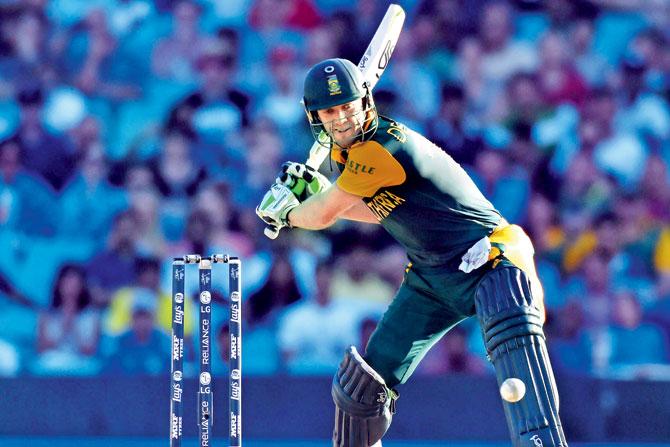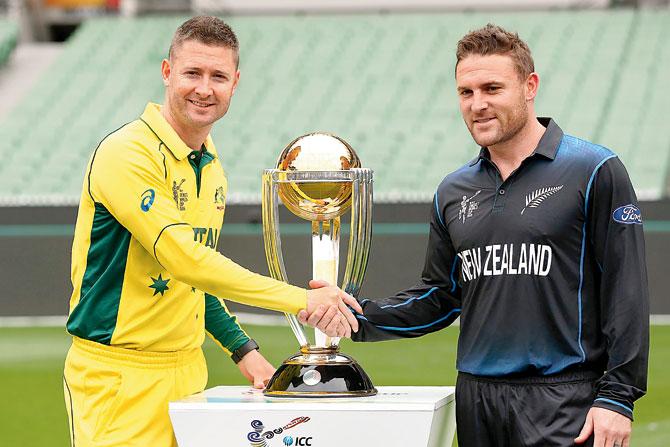ODIs are viewed as a game of containment. Well, I’ve never seen a better way to contain batsmen than by dismissal or recall a run made while a player was sitting in the pavilion, writes former Aussie great

Sydney: Are limiting regulations the reason many captains are conservative in their ODI approach or are there too many unimaginative skippers who are relieved to be bound by stifling playing conditions?
It’s no coincidence that the three best sides in the World Cup, Australia, New Zealand and India, were captained aggressively. Michael Clarke, Brendon McCullum and MS Dhoni all took the attitude; “Bugger the regulations, taking wickets is what winning captaincy is all about.”
ADVERTISEMENT

South Africa’s AB de Villiers gets set to play a big shot during his unbeaten 162 in the 2015 Cricket World Cup game against West Indies at the Sydney Cricket Ground on February 27. PIC/AFP
Instead of being looked upon as purely a cricketing contest, too often ODIs are viewed as a game of containment. Well, I’ve never seen a better way to contain batsmen than by dismissal. I don’t recall a single run made while a player was sitting in the pavilion, unless you count pencil cricket during a rain delay.
Impossible, but...
It’s impossible to stifle the best batsmen, as witnessed by some of the extraordinary feats of AB de Villiers, the string of centuries amassed by Kumar Sangakkara and two history-making double hundreds by Chris Gayle and Martin Guptill. When it’s ‘their day’, players of that calibre will still regularly reach the boundary and clear it, no matter where the fieldsmen are placed, so the only hope is to try and dismiss them before the mayhem commences.
There were numerous complaints about ODIs being boring, especially in the middle overs. Consequently, a host of stringent playing conditions and gimmicks (like powerplays and super subs), were introduced. None of these were designed to stretch the captain’s imagination and the batting powerplay is a perfect example of how it dulls the initiative. The bulk of the batting powerplays are taken at the compulsory stage, which is either a case of taking the easy way out or thoughtlessness, or a combination of both.
With the dominance of bat over ball increasing every day - in part due to a superior weapon - it’s now become fashionable to retain wickets in order to launch a prolonged onslaught in the last 15 overs that are now treated as an elongated powerplay.
Now, that’s boring
What really makes the middle overs of an ODI boring is when the fielding captain is happy to ‘just’ concede six runs an over and the batting side gratefully accepts the gifts on offer. If little risk is applied to batting, because of deep and meaningless fields, only a desperate or impetuous batsman is going to gift his wicket by holing out in the deep.
How many times is it remarked upon that when captains are forced to bring fielders inside the circle by the regulations, a wicket is gained because a batsman holes out trying to loft a ball through the infield?
Cricket, like most sports is a game where winning trends are often copied. It’s to be hoped that the enterprising captaincy of Clarke, McCullum and Dhoni is replicated by other skippers.
I sympathise with captains having to deal with batsmen armed with lethal weapons that often make third man a more likely catching option than third slip.
Good captaincy
Nevertheless, Clarke, McCullum and Dhoni showed that, backed by good bowling, the search for wickets throughout an innings can be fruitful.

Apart from introducing encouraging regulations - like reducing the field restrictions and having more flexible over allowances for bowlers -- the way to improve captaincy is via pro-active selection. If selectors both choose and encourage aggressive captains and sack those who show little initiative, it’ll send a strong message to prospective skippers. For maximum success, this policy needs to be implemented from the bottom up (club, first-class, international) rather than top down.
A well played ODI should be exciting for the crowd and fulfilling for the players. The format will remain a viable product as long as the regulations and the captains encourage a spirited contest between bat and ball and there are an increasing number of teams of roughly equal ability.
 Subscribe today by clicking the link and stay updated with the latest news!" Click here!
Subscribe today by clicking the link and stay updated with the latest news!" Click here!







